ABSTRACT
Background
The Advent of the COVID –19 pandemic has necessitated the quick exploration of new drugs. Synthetic approach is time consuming and expensive with uncertainty. The natural products can be explored as this approach is cost effective and takes less time to investigate. The ethnic significance of Grewia hirsuta has given clues of Immunomodulator potential. Hydro ethanolic extract of Grewia hirsuta was explored and compared with established levamisole.
Materials and Methods
In vitro, immunomodulator models on human lymphocytes and In vivo carbon clearance model in Swiss albino mice were studied by lymphotoxicity and lymphocyte proliferation.
Results
Hydro ethanolic extract of Grewia hirsuta has shown similar results of immunomodulation comparable with levamisole in statistically significant studies assessed by Dunnett’s test.
Conclusion
Hydro ethanolic extract has shown decreased lymphocyte toxicity and increased lymphocyte proliferation.
INTRODUCTION
The current trends indicate humans are susceptible to disease like SARS, HIV infections, Dengue fever, Zika virus etc. Changes in the environment has a negative impact on human well being which is reflected by weak immune response. The weak immune response is greatly influenced by nutritional aspects and as well humoral and cellular immunity. Existing immune modulatory drugs are acting by stimulating cellular hormones conducive for immune stimulation. The search for novel immune stimulant drugs is on high priority as available drugs are not matching the level of immuno stimulant and modulation activity.1
Advances in the histology have revealed the immunity can be broadly classified as cellular immunity and humoral immunity. Cellular immunity comprises of lymphocytes, basophiles, eosinophils, macrophages, natural killer cells, mast cells and T-cells, etc. which the selectively act on infectious bacteria and cancer cells.2,3 Lymphocytes are vital components of immune system in normal conditions and indicative of immune health. Their role in combating infections and cancer cells is well established. They also have a role in tissue rejection and autoimmune disorders. Neutrophils and monocytes are mobile cells which migrate to tissues and ingest and destroy micro-organism and dead tissues.4 In humoral immunity, molecular warfare which is stimulated by xenobiotics or foreign particles. The proteins which are not the part of the biological system are identified and antibodies specifically to combat the foreign molecule to synthesize in a customized manner. Hence, humoral immunity is highly specific and targeted.5 Grewia hirsuta Vahl. is documented as Nagabala (Ayurvedic herb) and in other ethnic systems of medicine.6
MATERIALS AND METHODS
Chemicals and reagents
Levamisole (Vermisole-150, Khandelwal Laboratories Pvt. Ltd., Mumbai), chemicals and reagents used for experimental work were of analytical grade.
Carbon in suspension
Pelikan-4001(German black ink).
Procurement and Authentication
The title plant was collected from natural habitat of Chittoor, Andhra Pradesh, India. The taxonomic identification of the plant was confirmed by Dr. K. Madhava Chetty, Plant Taxonomist (IAAT:357), Assistant Professor, Department of Botany, Sri Venkateswara University, Tirupati, Andhra Pradesh with a voucher number 072.
Preparation of Extract
The dried leaves of Grewia hirsuta was subjected to continuous hot extraction using a soxhlet apparatus to obtain hydro ethanolic extract. The extract obtained was concentrated, dried and stored in airtight container at cool temperature.7
Animals
Swiss albino mice (25-30 g) of either sex were used. The animals were fed with standard pellet diet and water ad libitum and maintained under standard environmental conditions (22±5°C with 12 hr of light/dark cycle).
Fixation of doses
Based on the literature survey, the acute toxicity study was carried and the lethal dose is 2000 mg/kg. Based on this we have selected 1/8th (250 mg/kg) and 1/4th (500 mg/kg) of the dose.8
Evaluation of in vitro immunomodulator activity
Lymphotoxicity test by MTT (3-[4,5-dimethylthiazol-2-yl]-2,5 diphenyl tetrazolium bromide) method
In vitro lypmhotoxicity and lymphocyte proliferation was evaluated by measuring the reduction of MTT by colorimetric assay. MTT was converted to formazan crystals (dark purple) in the mitochondria. Formazan crystals were formed gets entrapped in the mitochondria due to its insolubility. This reaction catalyzed by the enzyme succinate dehydrogenase present in the mitochondria. The water-insoluble formazan produced was solubilized by dissolving in a solvent Dimethylsulfoxide (DMSO) and measured colorimetrically. The viable cells are only capable of metabolic conversion. Hence, the extent of formazan formation is an indicative of viable cells as described by Mahshid Ghasemi et al., 2021.9
Preparation of test dilutions
(HEEGH) 1 g was dissolved in 5 mL 70% ethanol and it was sterilized by filtration method using 0.22 μm syringe filter. HEEGH concentrations were prepared in dulbecco’s modified eagle medium/nutrient mixture F-12 (DMEM/F12) + 10% Fetal Bovine Serum (FBS) (complete medium) at different concentrations (w/v) by serial dilution (1 fold dilution). Whereas, 70% ethanol was used as vehicle control and Phytohemagglutinin (PHA) was used as standard (positive control).
Cells and controls
Heparinized human peripheral blood (10 mL) was collected from the diagnostic laboratory (Kripa Clinical Laboratory, Bengaluru) for this study. Lymphocytes were separated by Ficoll-Hypaque density gradient method, and cells were counted by haemocytometer method. Tissue culture complete medium (i.e. 90% DMEM/F12+10% FBS) was used as a control.
Cell culture
Lymphocytes are plated in triplicates to minimize the variability of the results. 100 μL of cell suspension (2000 cells/well) was used. Approximately 80,000 live cells with 97% viability were seeded into 96-well culture plate (100 μL each well), leaving the first- row empty (i.e., 35-wells total). The plate was observed under microscope and incubated for 24 hr.
Exposure of Lymphocytes to test compound
The HEEGH was added to the 96-well plate at 2 mg/100 μL, 1 mg/100 μL, 0.5 mg/100 μL, 0.25 mg/100 μL, 0.12 mg/100 μL, 0.06 mg/100 μL, 0.00 mg/100 μL (w/v) concentrations. Complete media (RPMI+10% FBS) were used as media control, 70% ethanol, 10 μL/100 μL (v/v) was used as vehicle control, whereas, 100 μg/100 μL, 80 μg/100 μL, 60 μg/100 μL, 40 μg/100 μL, 20 μg/100 μL, 10 μg/100 μL, 0.00 μg/100 μL Phytohemagglutinin (PHA) was used as standard (positive control) (Figure 1).

Figure 1:
Exposure of Lymphocytes to HEEGH for 72 hr.
Incubation period
Lymphocytes were exposed to HEEGH by incubating for 72 hr to determine the proliferation of cells against each test compound in an incubator with 5% CO2 at 37°C and 90% Rh.
MTT-incubation
After 72 hr of HEEGH exposure, added (10 μL MTT+90 μL plain/ incomplete medium) MTT solution (5 mg/mL). The plates were placed in the plate-shaker and allowed for 5 min at 900 shakes/ min. Later, the plates were incubated for 4 hr at 37°C in a CO2 incubator.
Dissolution of formazan crystals
Lymphocyte Proliferation Assay
Lymphocyte proliferation is an important property of an all immune stimulant drugs. Lymphocyte proliferation occurs by a complex protein synthesis cascade. Immunostimulant drug is going to stimulate in the cascade mechanism and thus manifesting immunostimulant activity. In this method, high throughput screen ELISA plate reader is applied through MTT formazan assay method it was used in immunotoxicity assay. Our results indicate dose dependent immunostimulant activity of lymphocyte proliferation see Table 1. This assay is compared with the standard immunostimulant proliferation with levamisole.14–17
| Drug conc. in mg/100 μL | Average 0.D at 570nm | Cell viability in % | Cell Death in % |
|---|---|---|---|
| Media control | 0.369 | 100 | 00 |
| Vehicle control | 0.362 | 98.10 | 1.90 |
| PHA | 0.438 | 118.69 | 00 (-18.69) |
| HEEGH Conc. in W/V | |||
| 2 | 1.193 | 323.30 | 00 (-223.30) |
| 1 | 1.153 | 312.46 | 00 (-212.46) |
| 0.5 | 1.103 | 298.91 | 00 (-198.91) |
| 0.25 | 0.902 | 244.44 | 00 (-144.44) |
| 0.12 | 0.595 | 161.24 | 00 (-61.24) |
| 0.06 | 0.460 | 124.66 | 00 (-24.66) |
| 0 | 0.357 | 96.74 | 00 (3.26) |
Effect of HEEGH on cell viability and cell death by MTT method
Calculation
The percentage of cell viability is calculated using the following equation:
In vivo Carbon Clearance Assay
Phagocytosis is a property of white blood cells which engulf bacteria, virus and other foreign substances and offer prevention of harm by the organisms and substances. So, the capacity to engulf foreign organisms and substances is assessed by phagocytic index is the parameter which measures the average number of bacteria ingested per phagocyte in an incubated mixture of bacteria, phagocytes, and blood serum.
Swiss albino mice (25-30 g) were divided into four groups, consisting of six animals each.
Group I: Control-distilled water (10 mL/kg, p.o).
Group II: Standard-levamisole (50 mg/ kg, p.o).
Group III: Lower dose-HEEGH (250 mg/kg, p.o).
Group IV: Higher dose-HEEGH (500 mg/kg, p.o).
The treatment was given for 5 days and, after 48 hr of the last treatment, mice were injected via the tail vein, carbon ink suspension (0.1 mL). Blood samples were drawn (in EDTA solution 5 μl) from the retro-orbital sinus at 0 and 15 min, a 25 μL sample was mixed with 2 mL of 0.1% sodium carbonate solution and its absorbance was determined at 660 nm.
The phagocytic index was calculated using the following equation:
Where,
OD1=Optical Densities at 0 min.
OD2=Optical Densities at 15 min.
Leukocytes count was also carried for all the groups. Lymph node and spleen were isolated and histopathology studies were carried out in order to study qualitative lymphocyte proliferation property.18–21
Statistical Analysis
Experimental results were presented as mean±SEM (n=6) and the statistical significance between the groups was analyzed by means of one way Analysis of Variance (ANOVA) followed by Dunnet’s multiple comparison test Where,*p<0.05, **p<0.01 ***p<0.001 as compared to control by using In Stat GraphPad Prism Version 6.00 (GraphPad Prism Software).
RESULTS
In vitro Lymphotoxicity Test by MTT Method
The optical density at 570 nm were presented in Table 1, from this value percentage of cell viability and cell death were calculated which is given in the Table 1. The results indicate dose dependent cell viability variations at zero concentration of HEEGH showed 96.74% and at 2mg/100 μL showed cell viability of 323.30% (see Table 1 and Figures 3, 4 and 5).
| Group | Dose (mg/kg) | Phagocytic Index |
|---|---|---|
| Control (Vehicle) | 10 mL/kg p. | 1.011±0.010 |
| Standard (Levamisole) | 50 mg/kg p.0 | 1.516±0.039*** |
| Lower dose (HEEGH) | 250 mg/kg p.0 | 1.194±0.061* |
| Higher dose (HEEGH) | 500 mg/kg p.0 | 1.462±0.048*** |
Effect of HEEGH on phagocytic index in carbon clearance assay.
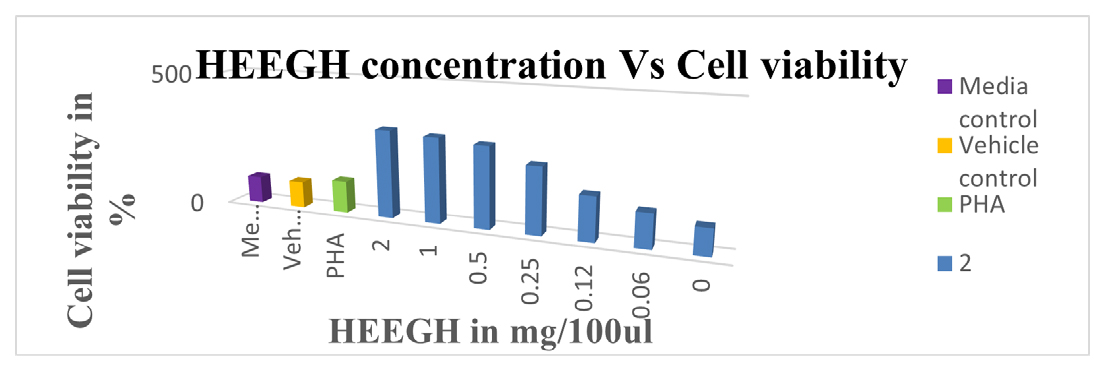
Figure 3:
Effect of HEEGH on cell viability in lymphotoxicity test.
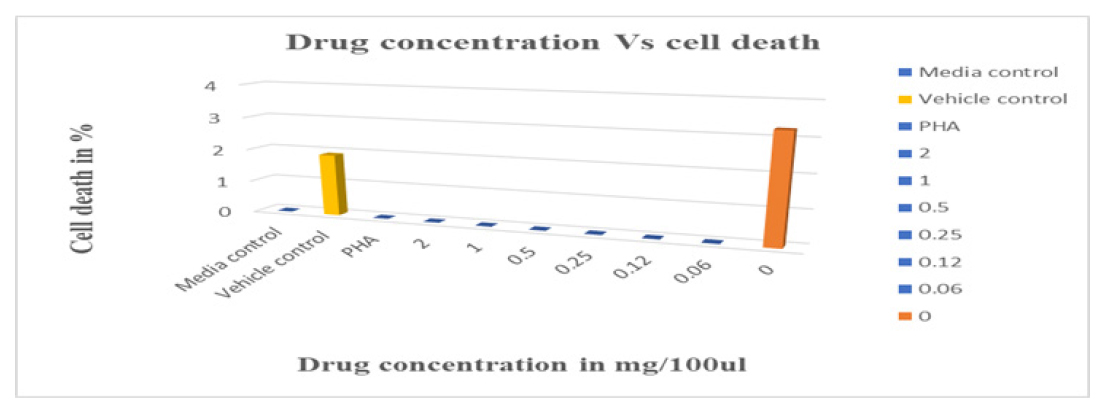
Figure 4:
Effect of HEEGH on cell death in lymphotoxicity test.
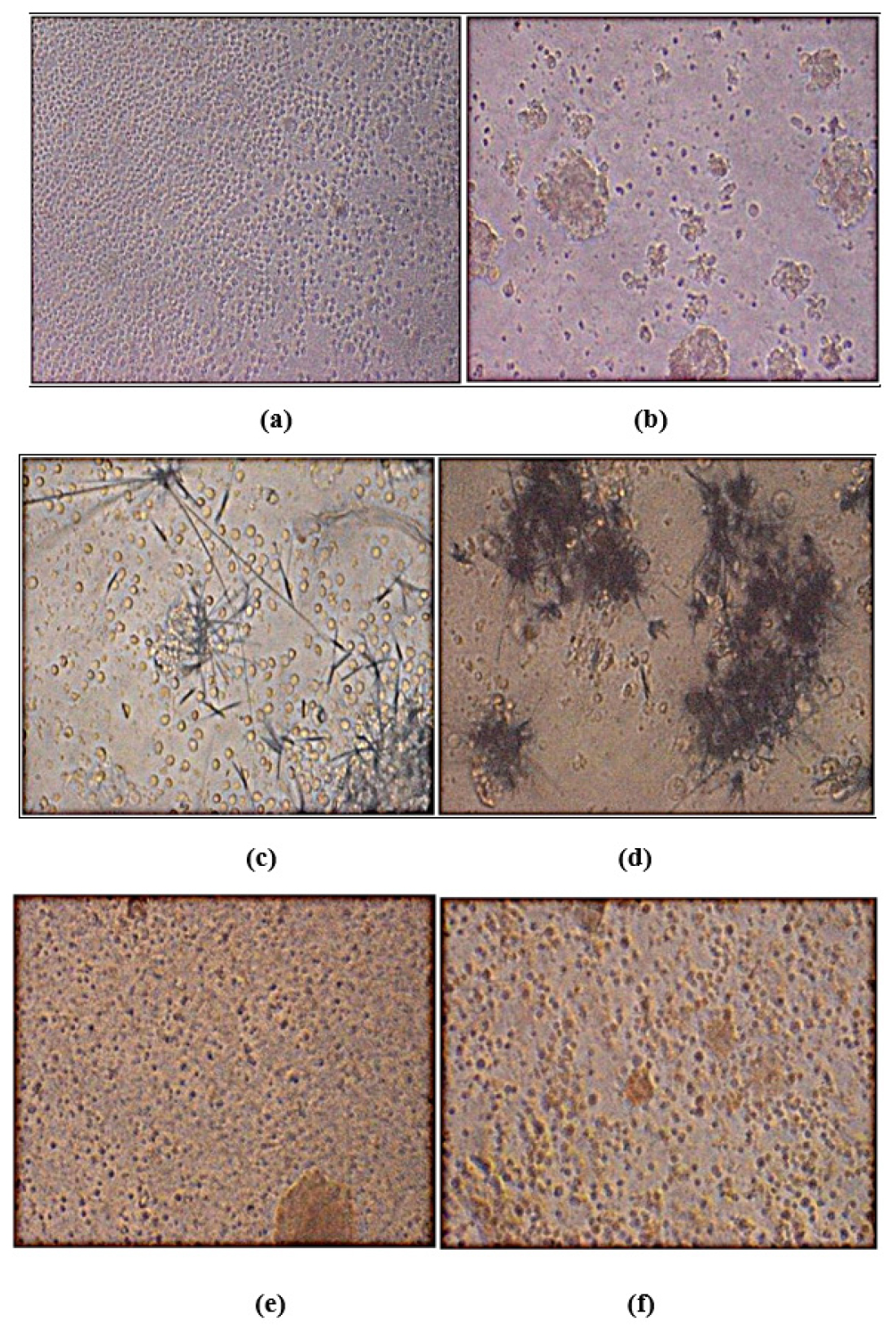
Figure 5:
(a) Media control after 72hr drug expose. (b) PHA after 72hr drug expose. (c) Media control after crystal Formazen. (d) PHA after crystal formazen. (e) HEEGH 0.06 mg after 72 hr expose (Lymphocytes toxicity). (f) HEEGH 1 mg after 72 hr expose (Lymphocytes toxicity).
In vitro Lymphocyte Proliferation Test by MTT Method
Lymphocyte proliferation is an important index of immunostimulant activity. In our experiment, the lymphocyte proliferation showed a dose dependent lymphocyte proliferation see Table 1 and Figure 6. The lymphocyte proliferation activity of HEEGH was observed highest proliferation compared to media control 2000 cells/well, and levamisole 2725 cells/well and HEEGH 4962 cells/well shown in Figure 6. Hence, HEEGH at dose 2 mg/100 μL has statistically significant compared to levamisole and media control observed in a dose dependent manner which is shown Figure 6. Lymphocyte proliferation is an index of immunostimulant activity is remarkable a dose level 2mg/100 uL (Figures 5 and 7).
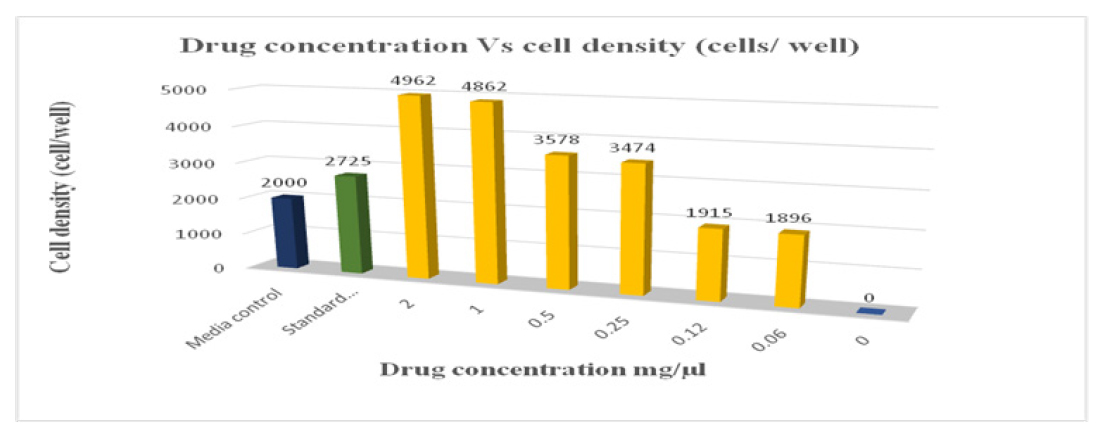
Figure 6:
Effect of HEEGH on cell density in lymphocyte proliferation.
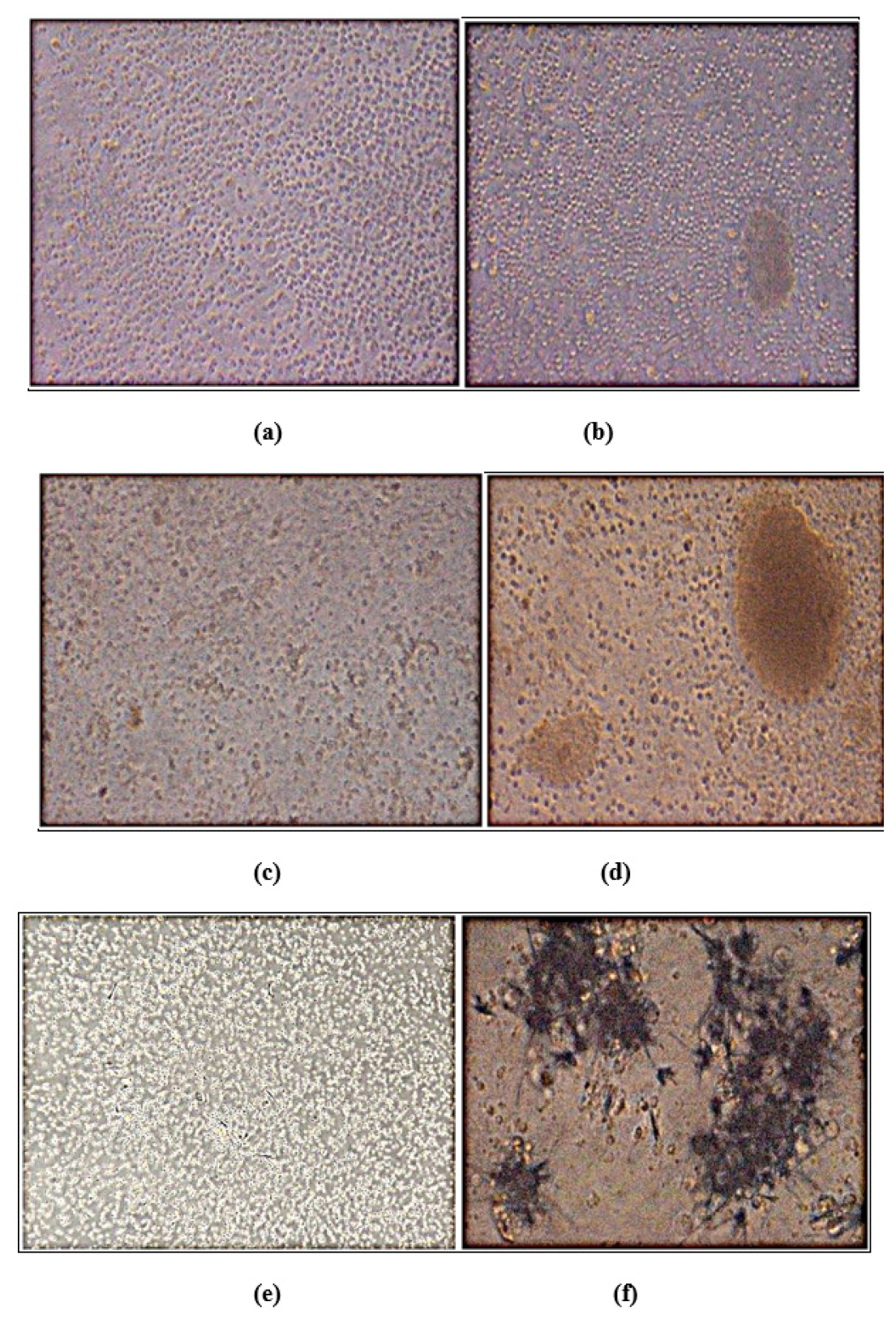
Figure 7:
(a) STD (Levamisole, 10mg) after 72 hr expose. (b) STD (Levamisole, 100 mg) after 72 hr expose. (c) HEEGH 0.06 mg after 72 hr expose (Lymphocyte Proliferation). (d) HEEGH 2 mg after 72 hr expose (Lymphocyte Proliferation). (e) Lymphocytes under 10x magnification. (f) MTT metabolization by proliferating lymphocytes 40x magnification.
In vivo Immunomodulatory Activity Using Carbon Clearance Assay
The results indicate the phagocytic index of the test dose at 500 mg is comparable with standard levamisole (50 mg/kg) and showing dose dependent action (Table 2). An increase in the leukocyte number is an immunostimulant action of levamisole. In our experiment levamisole has boosted leuckocyte count 11.25±1.23, whereas control is 7.76±1.05. The HEEGH has also shown increase in leuckocyte count on dose dependent manner at lower dose 8.68±1.49 and at higher dose 10.03±1.20 which is compare with levamisole activity. The results are presented in (Table 3) and (Figures 8 and 9).
| Group | Dose (mg/kg) | Leukocytes (103/uL) |
|---|---|---|
| Control (Vehicle) | 10 mL/kg p.0 | 8.093±0.25 |
| Standard (Levamisole) | 50 mg/kg p.0 | 11.25±0.30*** |
| Lower dose (HEEGH) | 250 mg/kg p.0 | 8.520±0.28* |
| Higher dose (HEEGH) | 500 mg/kg p.0 | 9.846±0.2918*** |
Effect of HEEGH on number of leukocytes in carbon clearance assay.
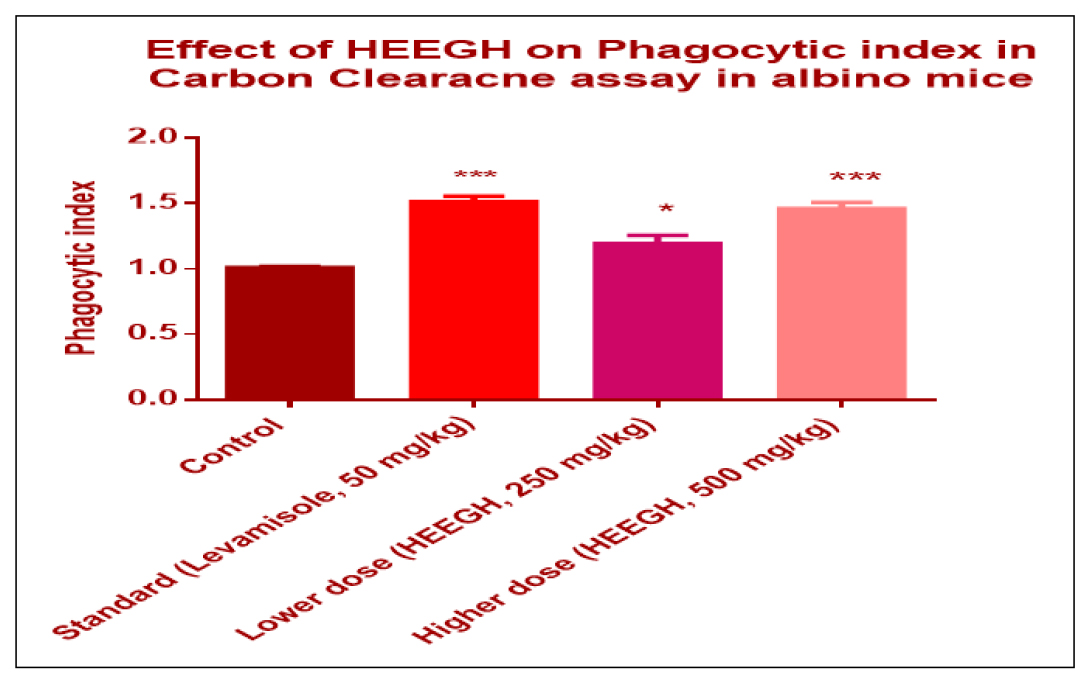
Figure 8:
Effect of HEEGH on Phagocytic index in carbon clearance assay.
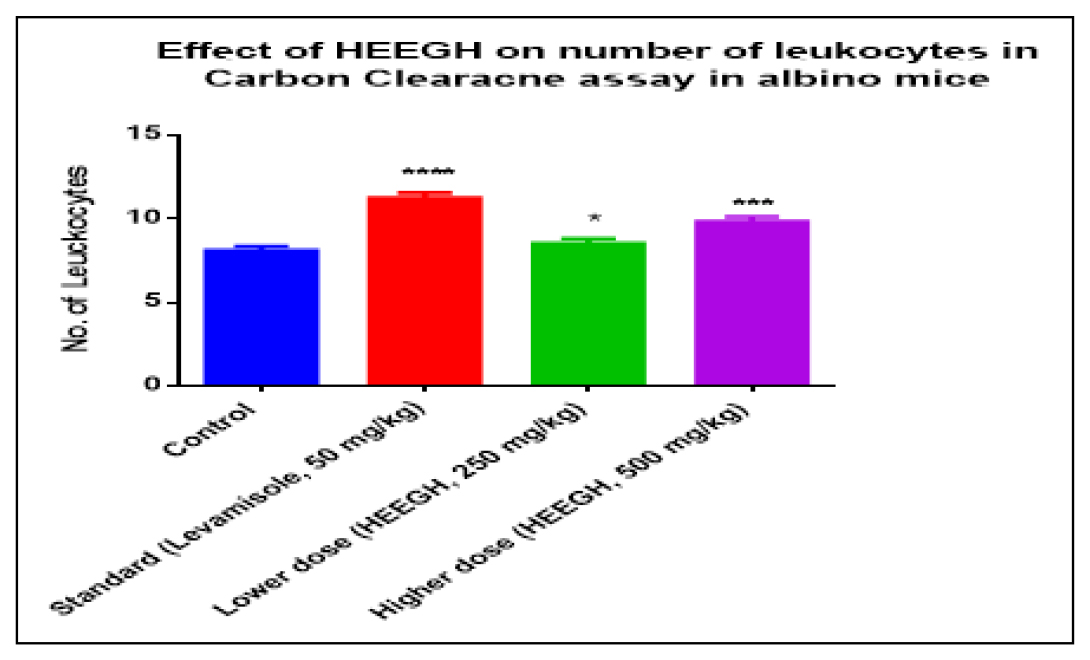
Figure 9:
Effect of HEEGH on number of leuckocytes in carbon clearance assay.
Histopathology of Spleen of mice in Carbon clearance assay
Histopathology slides studied from the spleen showed white pulp and red pulp. Spleen anatomically divided into comprising of lymphoid arterioles. Red pulp consists of macrophages and reticular meshwork. The main function of the spleen is to pool and destroy the old and defective RBCs from the circulation. Whereas white pulp, is the source of macrophages which are processed in the white pulp. In our study, we observed mild to moderate action of levamisole and HEEGH which are administered as lower dose and higher dose. In the red pulp considerable increase in macrophages engulfing and destroying RBCs was clearly observed in at higher dose in levamisole treated and lower dose of HEEGH there is a marginal increase in the red pulp (Figures 10).

Figure 10:
(a) Photomicrograph section of the spleen of Albino Swiss mice of control at 100 x and 400 x magnification Hematoxylene and Eosin stain [H&E]. (b) Photomicrograph section of the spleen of Albino Swiss mice of standard. (c) Photomicrograph section of the spleen of Albino Swiss mice of lower dose. (d) Photomicrograph section of the spleen of Albino Swiss mice of higher dose.
Histopathology of Lymph node of mice in Carbon clearance assay
Section studied from the lymph node showed intact architectureconsistingofanintactcapsulewithcortexandmedulla. The cortex consists of diffuse lymphoid cells and the medulla shows few congested blood vessels in control in albino mice. Section studied from the lymph node showed intact architecture consisting of an intact capsule with cortex and medulla. The cortex consists of diffuse lymphoid cells and the medulla shows mild congested blood vessels in standard (Levamisole 50 mg/kg) group in albino mice. Five days of pretreatment with HEEGH (250 mg/kg) showed the section studied from the lymph node showed intact architecture consisting of an intact capsule with cortex and medulla. The cortex consists of mild depletion of lymphoid cells and the medulla shows with mild congested blood vessels on albino mice. Similarly, higher dose (500 mg/kg) had shown the section studied from the lymph node shows intact architecture consisting of intact capsule with cortex and medulla. The cortex consists of moderate depletion of lymphoid cells and the medulla shows mild congested blood vessels in albino mice (Figures 11).

Figure 11:
(a) Photomicrograph section of the lymph node of Albino Swiss mice of control at 100 x and 400 x magnification Hematoxylene and Eosin stain [H&E]. (b) Photomicrograph section of the lymph node of Albino Swiss mice of standard. (c) Photomicrograph section of the lymph node Albino Swiss mice of lower dose. (d) Photomicrograph section of the spleen of Albino Swiss mice of higher dose.
DISCUSSION
Immunomodulator and immunostimulant activities are established for Centella asciatica, Curcuma longa L. Panax ginseng, Withania somminfera etc. Immunostimulant means in case of weak immune response immunostimulant drug is going to improve the immunity by cellular and humoral actions. Whereas, in the immunomodulation fine tuning of immune response is observed in case immune response is either dominant or weak. An immunomodulation happens by leveraging the cellular and humoral immunity. For example, Withania somnifera is a good example of immunostimulant and immunomodulatory.22,23
A battery of tests was conducted on human lymphocytes, in vitro and in vivo in albino mice. In vitro studies lymphocyte toxicity and proliferation were measured. The levamisole 50 mg/kg has shown reduced lymphocyte toxicity and enhanced lymphocyte proliferation compared to the control group. A similar observation of reduced lymphocyte toxicity and enhanced lymphocyte proliferation is observed comparable with levamisole effect. This indicates the HEEGH is having at least lympho toxicity and lympho proliferation similar to levamisole. It may be expected to be an immunomodulatory candidate like levamisole.
HEEGH is also showing increased phagocytic index and increased the total leukocyte count similar to levamisole effect. Histopathological studies on spleen and abdominal lymph nodes indicate enhanced viable cells similar to levamisole and supportive of the enhanced imunomodularoy effect of levamisole and HEEGH at different doses.
CONCLUSION
In our studies, the HEEGH has shown in vitro and in vivo experiments of decreased lymphocyte toxicity and increased lymphocyte proliferation. Further studies are required to establish active constituents responsible for immunomodulatory effect.
Cite this article
Chikkamath V, Kulkarni V, Habbu P, Nagappa AN. In vitro and In vivo Immunomodulatory Activity of Hydro Ethanolic Extract of Grewia hirsuta Vahl. Int. J. Pharm. Investigation. 2024;14(2):539-46.
ACKNOWLEDGEMENT
The authors thankful to the Management and Principal of SCS College of Pharmacy, Harapanahalli and SET’s College of Pharmacy, Dharwad for providing all necessary facilities to carry out research work.
The authors thankful to the Management and Principal of SCS College of Pharmacy, Harapanahalli and SET’s College of Pharmacy, Dharwad for providing all necessary facilities to carry out research work.
ABBREVIATIONS
| COVID-19 | Corona virus disease of 2019 |
|---|---|
| DMEM | Dulbecco’s Modified Eagle’s Medium |
| DMSO | Dimethyl sulfoxide |
| ELISA | Enzyme-linked immunosorbent assay |
| FBS | Fetal bovine serum |
| HEEGH | Hydro ethanolic extract of Grewia hirsuta |
| HIV | Human immunodeficiency virus |
| MTT | 3-(4,5-dimethylthiazol-2-yl)- 2,5-diphenyl tetrazolium bromide |
| PHA | Phytohemagglutinin |
| RBC | Red blood cells |
| SARS | Severe Acute Respiratory Syndrome |
References
- Tabish SA. Recent trends in emerging infectious diseases. Int J Health Sci (Qassim). 2009;3(2):5-8. [PubMed] | [Google Scholar]

- Chaplin DD. Overview of the immune response. J Allergy Clin Immunol. 2010;Array((2) Suppl):S3-23. [PubMed] | [CrossRef] | [Google Scholar]

- Marshall JS, Warrington R, Watson W, Kim HL. An introduction to immunology and Immunopathology. Allergy Asthma Clin Immuno. 2018;14(Supply2):49 [PubMed] | [CrossRef] | [Google Scholar]

- Available fromhttps://primaryimmune.org/immune-system-and-primary-immuno deficiency [internet] [accessed on 12/07/2023]

- Medina KL. Overview of the immune system. Handb Clin Neurol. 2016;133:61-76. [PubMed] | [CrossRef] | [Google Scholar]

- Chikkamath V, Kulkarni VH, Habbu PV, Kulkarni PV. Grewia hirsuta vahl chemical constituents and biological activities. RJPS. 2019;9(3):3-10. [CrossRef] | [Google Scholar]

- Gupta A, Naraniwal M, Kothari V. Modern extraction methods for preparation of bioactive plant extracts. IJANS. 2012;1(1):8-26. [CrossRef] | [Google Scholar]

- [accessed on 17/02/2024]. Available fromhttps://www.oecd-ilibrary.org/docserver/9789264071001[internet]

- Ghasemi M, Turnbull T, Sebastian S, Kempson I. The MTT Assay: utility, limitations, pitfalls, and interpretation in bulk and single-cell analysis. Int J Mol Sci. 2021;22(23):1-30. [PubMed] | [CrossRef] | [Google Scholar]

- Kumar P, Nagarajan A, Uchil PD. Analysis of cell viability by the MTT assay. Cold Spring Harb Protoc. 2018;2018(6):1-10. [PubMed] | [CrossRef] | [Google Scholar]

- Ogbole OOOO, Segun PA, Adeniji AJ. In vitro cytotoxic activity of medicinal plants from Nigeria ethnomedicine on Rhabdomyosarcoma cancer cell line and HPLC analysis of active extracts. BMC Complement Altern Med. 2017;17(494):1-10. [PubMed] | [CrossRef] | [Google Scholar]

- Attard E, Cuschieri A. In vitro immunomodulatory activity of various extracts of Maltese plants from the Asteraceae family. J Med Plant Res. 2009;3(6):1-5. [PubMed] | [CrossRef] | [Google Scholar]

- Anitha T, Parameswari K, Kishori B, Usha R. Evaluation of in vitro immunomodulatory effects of soyabean (Gycine max. L) extracts on mouse immune system. IJPSR. 2015;6(5):2112-2120. [CrossRef] | [Google Scholar]

- Verma A, Prasad KN, Singh AK, Nyati KK, Gupta RK, Paliwal VK, et al. Evaluation of the MTT lymphocyte proliferation assay for the diagnosis of neurocysticercosis. J Microbiol Methods. 2010;81(2):175-8. [PubMed] | [CrossRef] | [Google Scholar]

- Weichert H, Blechschmidt I, Schroder S, Ambrosius H. The MTT-assay as a rapid test for cell proliferation and cell killing: application to human peripheral blood lymphocytes (PBL). Allerg Immunol (Leipz). 1991;37(3-4):139-44. [PubMed] | [Google Scholar]

- Van de Loosdrech AA, Beelen RH, Ossenkoppele GJ, Broekhoven MG, Langenhuijsen MM. A tetrazolium-based colorimetric MTT assay to quantitate human monocyte mediated cytotoxicity against leukemic cells from cell lines and patients with acute myeloid leukemia. J Immunol Methods. 1994;174(1-2):311-20. [PubMed] | [CrossRef] | [Google Scholar]

- Erniatia RFZ, Prangdimurtib E, Adawiyahb DR, Priosoeryantoc BP, Hudad N. Stimulating activity on human lymphocytes in vitro of nori like product (Geluring) made from Gelidium sp. and Ulva lactuca seaweeds. Int J Adv Sci Eng Inf Technol. 2020;10(3):1311-6. [CrossRef] | [Google Scholar]

- Dillasamola D, Aldi Y, Fakhri M, Diliarosta S, P BO, Noverial N, et al. Immunomodulatory effect test from Moringa leaf extract (Moringa oleifera L.) with carbon clearance method in male white mice. Asian J Pharm Clin Res. 2018;11(9):241-245. [CrossRef] | [Google Scholar]

- Sujono TA, Kusumowati ITD, Munawaroh R. Immunomodulatory activity of Muntingia calabura L. fruits using carbon clearance assay and their total flavonoid and phenolic contents. Asian J Pharm Clin Res. 2020;13(2):140-5. [CrossRef] | [Google Scholar]

- Meera S, Gupta Atyam VSSS, Kumar NS. Immunomodulatory and antioxidant activity of a polyherbal formulation. Int J Pharmacol. 2008;4(4):287-91. [CrossRef] | [Google Scholar]

- Sahu MS, Mali PY, Waikar SB, Rangari VD. Evaluation of immunomodulatory potential of ethanolic extract of Roscoea procera rhizomes in mice. J Pharm Bio allied Sci. 2010;2(4):346-9. [PubMed] | [CrossRef] | [Google Scholar]

- Safriani N, Rungkat FZ, Yuliana ND, Prangdimurti E. Immunomodulatory and antioxidant activities of select indonesian vegetables herbs and spices on human lymphocytes. Int J Food Sci. 2021:1-12. [PubMed] | [CrossRef] | [Google Scholar]

- Albrahim T, Alnasser MM, Al-Anazi MR, ALKahtani MD, Alkahtani S, Al-Qahtani AA, et al. In vitro studies on the Immunomodulatory effects of Pulicaria crispa extract on human THP-1 monocytes. Oxid Med Cell Longev. ;2020:1-14. [PubMed] | [CrossRef] | [Google Scholar]



